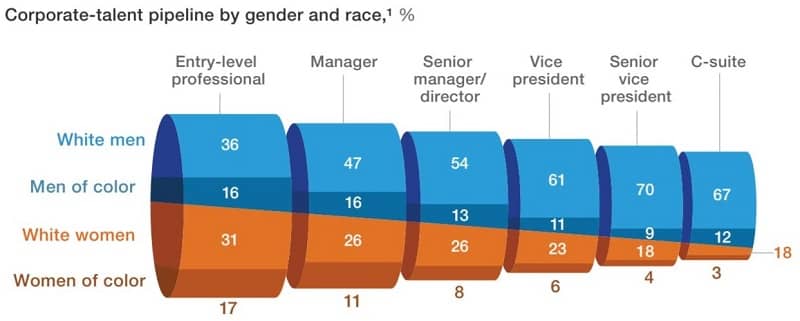Why do men (still) earn more than women? Why does Eveline find a job more quickly than Fatima? Why does Gerrit (61) always lose out to Thomas or Sanne (32). Or is Mădălina not offered her assessment in her native language? As DE&I policies gain traction, these practices still hurt your eyes.
In 2018, McKinsey published a global study on diversity in “the pipeline.” In the illustration, you can see how diversity is distributed among the different layers of the surveyed organizations (listed organizations in G20). And what we already know, we see here, expressed in numbers: the higher the level of the organizational structure, the less diverse it becomes. And yes, according to this study, this also applies to Europe.

So diversity, equity, and inclusion are not the same thing; they reinforce each other. Diversity does not mean everyone feels at home and gets equal opportunities to develop in your organization. A diverse organization is not necessarily inclusive, while in an inclusive organization, diversity is usually acceptable.
Diversity is generally found easier to begin with, though. Just by (visually) scanning an organization, you can identify and monitor ethnic, racial, and/or gender diversity. In fact, diversity is step 1, and equity is step 2 to achieve an inclusive organization.
In an inclusive organization, where everyone feels happy, rules, systems, and processes are reviewed for fairness and equality. Such a review is very confrontational. You can be assured that current systems and processes are not equitable.
Reviewing for equity requires leadership and a willingness to change. If you want your organization to grow into an inclusive organization, accept cultural change.
Culture change: brrrrr. So why pursue an inclusive organization anyway? There are two reasons for that: one good reason and one excellent reason:
An inclusive organization must evolve. I am referring mainly to “growing toward each other.” An organization with a wide diversity of people needs to build a collective memory. That means understanding each other, listening to each other’s stories, creating awareness, naming obstacles, and getting in tune with each other. To build a collective memory, you need time and respect. In addition, leaders must have already begun dismantling systems of discrimination and subordination.
Leaders must persevere in this process. But then you build an organization that is sustainably connected to society, stimulates innovation from every conceivable angle, moves faster than its competitors, can surprise customers repeatedly, and generates better profits than before.
Or call: +31 88 – 277 377 6
To call directly: +31 88 277 377 6
Subscribe to new comments